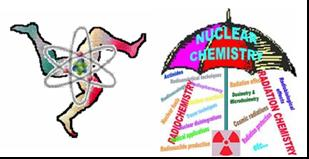Speaker
Dr
Cemal OZEROGLU
(Istanbul University Faculty of Engineering Department of Chemistry 34320 Avcilar-Istanbul/TURKEY)
Description
Toxic or radioactive metals cause progressive or irreversible renal injury and in acute cases, may lead to kidney failure and dead (1-3). Nuclear technologies have provided a better quality of different fields of life. However, this leads to accumulation of substantial amounts of radioactive wastes or waste solutions and the radionuclide 137Cs is produced in high yield during the fission processes. It is potentially very hazardous nuclide due to its long half-life (t1/2=30.17 years) and is a very radiocontaminant having high solubility in aqueous media (1, 4-6). Therefore there is a need for removal/separation of toxic or radionuclide metal ions from aqueous waste solutions or wastes by using organic or inorganic adsorbents. Many separation and preconcentration techniques such as chemical precipitation, ion-exchange, solvent extraction and sorption on the solid have been developed to remove metal ions from aqueous waste solutions. Nowadays, there is an increasing effort for removing toxic or radionuclide contaminants from aqueous waste solutions or wastes by using various polymeric adsorbents (6-10). It is also known that the use of polymeric adsorbents has advantages for controlling adsorption capacity and may present selective adsorption of metal ions from waste solutions.
In this study, a crosslinked copolymer has been proposed to remove Cs(I) ions from aqueous solutions. For this purpose, the crosslinked copolymer of ethylene glycol dimethacrylate(EGDM) and methacrylic acid (MA) containing 25% of MA as weight percentage was synthesized by using benzoyl peroxide (BPO)-N,N-dimethyl aniline (DMA) initiator system at room temperature. The available groups of carboxylic acid in the crosslinked copolymer were converted to the groups of sodium methacrylate using 2 N NaOH solution. The adsorption behavior of cesium ions on the densely crosslinked poly(sodium methacrylate) from aqueous solutions were investigated by the technique of ICP-MS measurements. Batch adsorption method was used to analyze the Cs(I) adsorption as a function of parameters such as the amount of adsorbent, contact time, pH of solution, initial Cs(I) concentration and temperature. Adsorption data obtained from experimental results have been tested for a number of kinetic and isotherm equations. The constants in adsorption isotherm and kinetic equations have been determined. The adsorption free energy has been calculated by using D-R isotherm to adsorption data.
References
1. Sheha R. R., Metwally E., J. Hazard. Mater., 143 (2007) 354-361.
2. Özeroglu C., Keçeli G., Radiochim. Acta, 97 (2009) 709-717.
3. Mellah A., Chegrouche S., Barkat M., J. Colloid and Interface Sci., 296 (2006) 434-441.
4. Cho Y., Komarneni S., Appl. Clay Sci., 43 (2009) 401-407.
5. Başçetin E., Haznedaroğlu H., Erkol A.Y., Appl. Radiat. Isotop., 59 (2003) 5-9.
6. Zhang Z., Xu X., Yan Y., Desalination, 263 (2010) 97-106.
7. Özeroğlu C., Keçeli G., Radiochim. Acta, 95 (2007) 459-466.
8. Maheswari M.A., Subramanian M.S., React. Funct. Polym., 66 (2006) 1452-1464.
9. Özeroğlu C., Keçeli G., J. Radioanal. Nucl. Chem., 268 (2006) 211-219.
10. Choi S-H., Nho Y.C., Radiat. Physics and Chem., 57 (2000) 187-193
Primary author
Dr
Cemal OZEROGLU
(Istanbul University Faculty of Engineering Department of Chemistry 34320 Avcilar-Istanbul/TURKEY)
Co-authors
Ms
Emine DOĞAN
(Istanbul University Faculty of Engineering Department of Chemistry)
Dr
Gönül KEÇELİ
(Istanbul University Faculty of Engineering Department of Chemistry)




